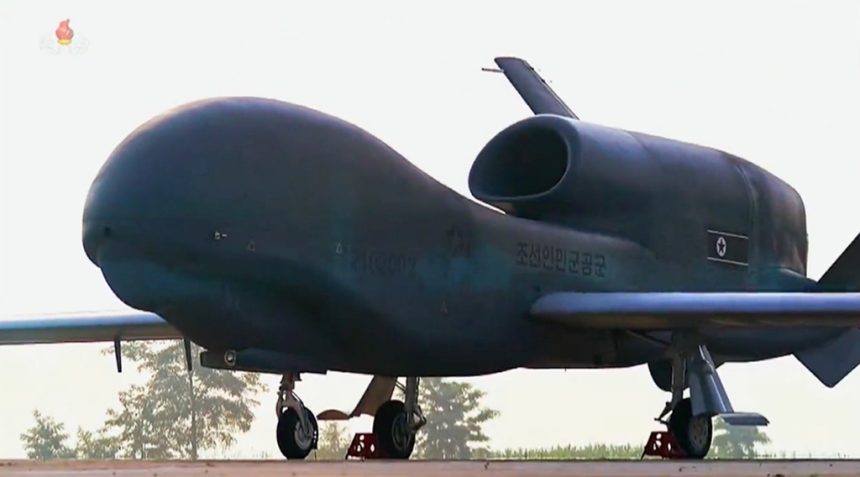First “indigenous” look-alike Global Hawk, Reaper drones made a notable first public appearance recently.
On July 27, 2023, North Korea unveiled its new line of drones with a copy of the U.S. RQ-4 Global Hawk and MQ-9 Reaper making an appearance. North Korea hosted its “Weapons and Equipment Exhibition 2023” in Pyongyang on Wednesday, in lieu of Russian Minister of Defence Sergei Shoigu visiting the country. Amongst the usual weaponry such as Hwasong-17 and Hwasong-18 ICBMs, North Korea’s first “indigenous” long endurance drones made a notable first public appearance.
Although development of the drones has been kept in the veils, it is expected that the origins of the development program date back to 2021. Back in January 2021, Kim Jong Un ordered the development of two UAV platforms: an unmanned striking equipment and a reconnaissance drone with an approximate range of 500km. According to KCTV the RQ-4 Global Hawk copy is designated Morning Star-4 (샛별-4, Saetbyol-4) and the MQ-9 copy the Morning Star-9 (샛별-9, Saetbyol-9). The numerical designation seems to be an obvious nod to the US counterparts.
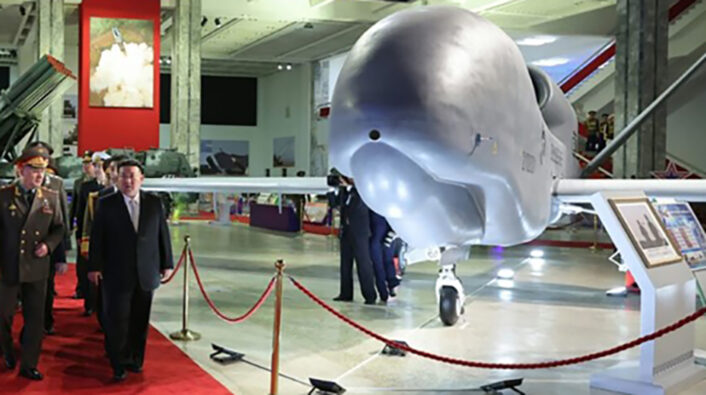
Morning Star-4
Perhaps the more interesting of the two is the long endurance strategic reconnaissance platform. As greatly evident from the pictures, the platform seems to be a direct copy of the Northrop Grumman RQ-4 Global Hawk. The overall layout of the aircraft is near identical to its original, from wing planform, engine nacelle shape. Analyst looking at satellite imagery of the drone spotted on a runway suggests a wingspan of around 35m (115 feet), near identical to that of the earlier Global Hawk model’s wingspan of 35.4m (116 feet).
To compare different elements of the Morning Star-4 to the RQ-4, many components are noticeable with a deeper look. The most obvious is external difference is the nose. Quite possibly the most important section of the aircraft, this is where most of the Global Hawk’s electronic suite is located. On the RQ-4 the upper bulge houses the 1.21m Ku-band SATCOM antenna, UHF LOS transceiver antenna, and IFF antenna. The upper nose fairing on the Morning Star-4 appears to be much smaller than that on the Global Hawk. Considering that even an optimistic estimation suggests a mere two North Korea owned satellites in orbit, the advent of SATCOM on the Morning Star-4 seems highly unlikely. Therefore, it is questionable if there is anything apart from a few small Line Of Sight transceivers inside the radome. Perhaps the fairing was left in place due to a concern in the change of aerodynamic handling characteristics rather than due to any meaningful payload requirement.
On the Global Hawk, the lower bulge front of the nose landing gear contains the main EO/IR sensor package including a rotating mirror with a 1.75m focal length IR sensor. There is an obvious lack of payload capacity in front of the nose landing gear on the North Korean drone. Only a small radome near the nose of the aircraft is present. The small hole in the front suggests a nose camera for piloted landings, similar to that found on the Global Hawk.
Aft of the nose landing gear, a gimbal mounted SAR/MTI antenna is present on the Global Hawk. However, a lack of a similar sized fairing denies the capacity for such payloads on the North Korean counterpart, let alone the technological development proving a Synthetic Aperture Radar exists at all within the KPAAF.
One small detail that stands out is the command datalink antenna radome located in the lower aft of the body. The feature looks identical to that of the Global Hawk. This piece is crucial as any data gained by the aircraft will be transmitted to the ground station via this terminal and it appears that the North Koreans decided not to veer too far from the original design.
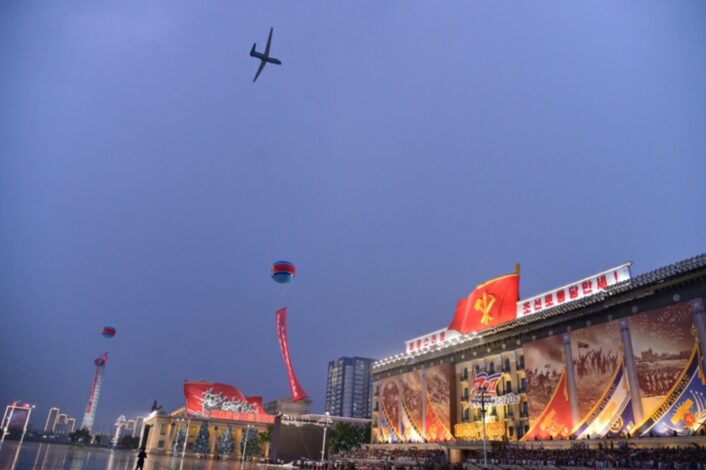
Furthermore, the aircraft was spotted conducting a flyover at the opening of a military parade held later the same day on the evening of July 27. Apart from this occasion, a few pictures of the drone conducting flight tests near the skyscrapers of Pyongyang were spotted on display at the exhibition. However, no pictures or press releases are yet to be available of the drone flying 20,000ft or higher.
It is worth noting that the neighbouring South Korean ROKAF have ordered 4 RQ-4 Global Hawks back in 2014. With the last of four Block 30 RQ-4 having introduced into service in 2020, the ROKAF have been operating the reconnaissance platform to its full capability since then. Although looking similar in appearance, it is no doubt that the actual ISR capabilities of the Morning Star-4 is severely lacking compared to its American counterpart. However, a general shift in North Korean doctrine and the efforts to modernise its air force is more meaningful than the drone itself.
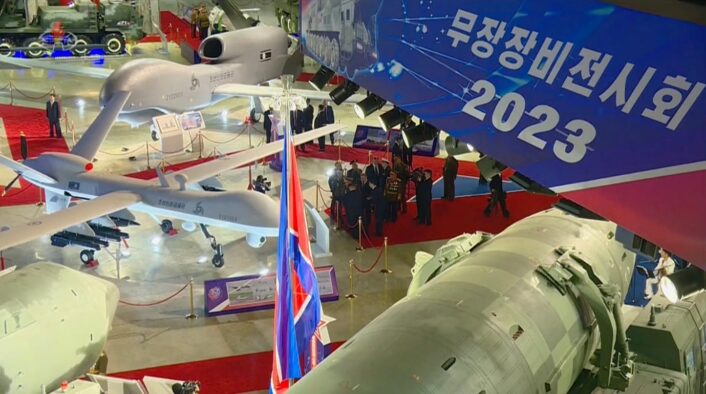
Morning Star-9
The other drone in question is the MQ-9 Reaper copy. The general layout closely resembles that of the Reaper with a three bladed prop and TV/IR camera turret. Similar to the Morning Star-4, the Morning Star-9 has a predicted wingspan that closely matches that of its US counterpart of 19.8m (65 feet).
The Morning Star-9 seems to resemble its US counterpart to a greater degree. It appears most antennas are mounted in a similar fashion to the Reaper. Both the C-band antenna pod and VHF/UHF aerial are present on the upper fuselage. The dome that houses a SATCOM dish on the Reaper is also present on the Morning Star-9 but as discussed previously the advent of SATCOM on North Korean drones is somewhat doubtful.
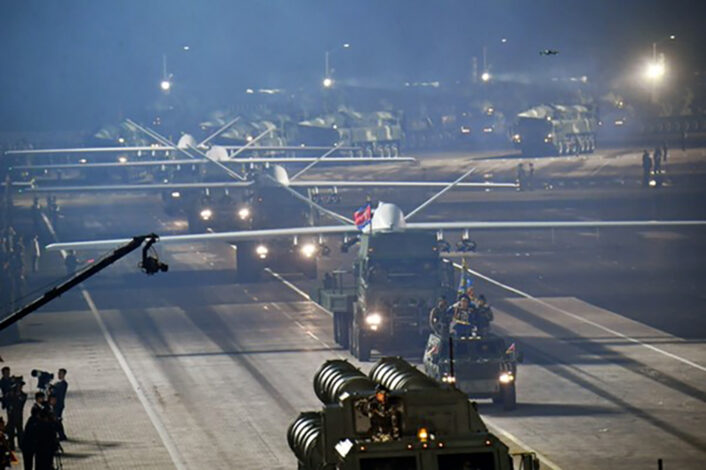
The nose turret houses four circular lenses which is suspected to house TV/IR cameras. The landing/piloting camera on the nose of the MQ-9 is also present on the Morning Star-9.
Probably the most notable difference between the Reaper and the Morning Star-4 is the presence of two extra hardpoints on the North Korean drone. The drone was pictured with three hardpoints on either wing, with four AGM-114 Hellfire type air-to-ground munitions and two glide bombs similar to the US GBU-39/B Small Diameter Bomb (SDB).
NEW: North Korea airs the first video footage of its two new military drones in action, showing a combat UAV firing missiles during flight. Read more about the unveiling here: https://t.co/AoOvLYVg2l pic.twitter.com/07uYQGJv3g
— NK NEWS (@nknewsorg) July 27, 2023
Based on the video provided by the North Korean news outlet the drone has been seen firing the Hellfire type AGM. South Korea currently operates K2 and K1A1 main battle tanks as their main fleet and the Hellfire is known to be capable of defeating any known MBTs with its shaped charge HEAT apart from those with Explosive Reactive Armour. Unlike the K1 series, the ROKA K2s have partial ERA coverage even going on its top side (which tends to be the least armoured portion on conventional tanks). It is worth noting that although the footage of the North Korean AGM firing has been released the video cuts off and does not show any impact tests nor are its capabilities officially known so far.
Compared to the hobby class sub-20kg drones with crudely mounted DSLR cameras the country has been sending down to South Korea a mere 6 years ago, the North Koreans have made significant technological advancement, albeit having directly copied work from the US. Although a short glance may suggests otherwise, it is believed that much work must be done to develop the actual ISR sensors that goes in these aircraft to make these platforms of any meaningful use. The drones will still be able to offer North Korea better ISR capabilities in the near future. Above all, the effort to modernise the air force and an overall shift in doctrine is more important than the individual platform development itself.

